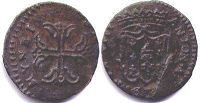Coins of Parma and Piacenza - catalog with values
Duchy of Parma and Piacenza (1556–1859)
Lira=20 soldi; Soldo=12 denari
Antonio Farnese (1727-1731)

sesino (6 denari) no date (1727-1729)
copper
SALUS MUNDI
ANTON I F P P DVX VIII
Coin value ~ 15-20 USD
Coins of other Italian States
Costs of Parma and Piacenza coins in this catalog approximate and indicated specifically for the coin shown in the picture.
I do not buy or sell coins - this is just a catalog.

